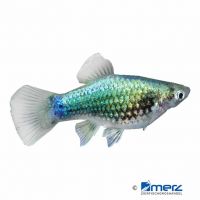Platy Tuxedo Neon Blue (Xiphophorus maculatus var.)
| Platy Tuxedo Neon Blue Xiphophorus maculatus var. | |
|---|---|
| Name | Platy Tuxedo Neon Blue |
| Name Lat. | Xiphophorus maculatus var. |
| Family | Livebearers |
| Family lat. | Poeciliidae |
| Order | Killifishes & Livebearers |
| Order lat. | Cyprinodontiformes |
| Origin | Central America |
| Habitat | Streams, ponds |
| Diet | Omnivore |
| pH | 7.0-8.5 |
| Behavior | Peaceful |
| Keeping | Group |
| Care Level | Easy |
| Reproduction | Livebearer |
| Breeding | Simple |
| Life Span | 2-3 years |
| Protection | No |
| Metric Units | |
| Size | 4-6 cm |
| Temperature | 20-25 °C |
| Hardness | 10-30 °dH |
| Aquarium | 60 cm / 54 l |
| US Units | |
| Size | 1.6"-2.4" |
| Temperature | 68-77 °F |
| Hardness | 178-534 ppm |
| Aquarium | 15 gal |
Distribution and habitat
The Neon Blue Tuxedo Platy is a cultivated form. The natural range of the Platy wild form extends from Veracruz in southeastern Mexico through Nicaragua and Guatemala to Belize. They live primarily in shallow, slow-moving waters, such as streams, ditches, and marshes with muddy bottoms and dense underwater vegetation.
Maintenance
The aquarium should have a varied, partly dense planting, with shelters and hiding places (roots) and provide sufficient swimming space. A dark substrate, some shaded light (floating plants) and medium to hard water is ideal.
No ammonia, ammonium and nitrite should be detectable, the nitrate value should not exceed 100 mg/l. To ensure the water quality and oxygen content, a filter and heater adapted to the aquarium size is required, as well as lighting for the species-appropriate day-night rhythm of the animals.
Diet
The food supply consists of live food, such as cyclops, daphnia, artemia and mosquito larvae, which is also accepted without problems in frozen form, plus commercially available frozen food mixtures, supplemented with high-quality dry food (flakes, granules). In addition, they regularly need vegetable food, such as algae leaves, crushed peas, mashed leafy and wild vegetables or dry food (flakes, granules) with high vegetable content (spirulina, kelp).
Only feed as much as will be eaten within a few minutes. Regular and varied feeding promotes health and prevents deficiency symptoms
Behaviour and compatibility
They are very peaceful fish, also intraspecies and well suited for a community tank with other calm and peaceful fish. It is recommended to keep at least 5 Platys together, whereby the number of females should predominate.
Basically, only compatible fish species with similar demands on water quality and water temperature should be socialized.
Sex dimorphism
Males are smaller and have an anal fin (gonopodium) that has been transformed into a mating organ. The females are larger and appear rounder.
Reproduction and breeding
Platies are live-bearing fish. Internal fertilization is facilitated by the male's gonopodium. Fertilized females are usually clearly identifiable by a dark colored pregnancy spot on the posterior abdomen. After 4-6 weeks of gestation, up to 80 fry are born. They are already fully developed and independent at birth. After they have filled their swim bladder at the water surface, they can immediately start feeding.
Fry must be fed several times a day with special rearing food. In community tanks breeding is hardly possible, because the young fish are easy prey.
Important
Platies are bred in many varieties, such as wagtail, lyratail, tuxedo, high fin, neon, red, green, black etc.. Mostly they are crosses with swordtails (Xiphophorus helleri) or parrot platy (Xiphophorus variatus).
Soft water is not tolerated well and makes them susceptible to disease. The addition of sea salt (mineral salt) from the pet store to harden the water prevents.
The well-being of the fish should be monitored regularly. The temperature should be checked daily, the pH value, hardness and nitrate value at least every 14 days. A regular partial water change is recommended, even if the pollutant load has not yet reached the upper limit. Sudden changes in water quality should be avoided. Newly introduced fish must be accustomed slowly to the water in the aquarium.
Further literature can be found in your pet store.
References
Text: petdata; Image: Merz Zierfischgroßhandel
Source: BMELV (1998): Tierschutzgutachten - Haltung von Zierfischen (Süßwasser); RIEHL & BAENSCH (2006): Aquarien Atlas Bd. 1, Mergus Verlag; ENGELMANN (2005): Zootierhaltung - Tiere in menschlicher Obhut: Fische, Verlag Harri Deutsch
- Gemäß § 21 Abs. 5 Tierschutzgesetz idgF
